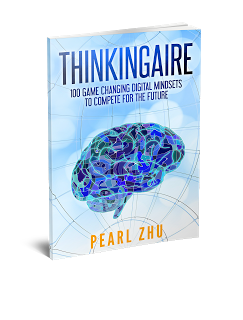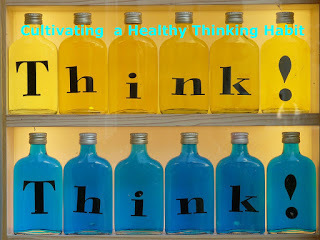Pearl Zhu's Blog, page 1295
September 21, 2016
The New Released Book "THINKINGAIRE - 100 Game-Changing Digital Mindsets to Compete for the Future" Introduction
“Change your thoughts and you change your world.” - Norman Vincent Peale
 We have moved into the new digital age when information is abundant and where creativity becomes a baseline competence. The race of human against machine is ongoing. The knowledge life cycle is significantly shortened, and the pace of information technology is so rapid that no one can rest on a static mindset, past accomplishments, or the wishful thought that everything is perfect the way it is. Indeed, mindset is far more important than talent. Talent can always be developed by those who keep growth in mind. From talent management perspective, are mindful leaders or workers simply found in nature or nurtured? How do human beings think? Where do you draw the line about which aspect of human activity is conscious thought and which is mere reflex? How do you differentiate between well thought-out reflex and simple physiological reflex? Further, what happens when the basic needs are fulfilled? Do we stop thinking? What is the philosophy of mindfulness?
We have moved into the new digital age when information is abundant and where creativity becomes a baseline competence. The race of human against machine is ongoing. The knowledge life cycle is significantly shortened, and the pace of information technology is so rapid that no one can rest on a static mindset, past accomplishments, or the wishful thought that everything is perfect the way it is. Indeed, mindset is far more important than talent. Talent can always be developed by those who keep growth in mind. From talent management perspective, are mindful leaders or workers simply found in nature or nurtured? How do human beings think? Where do you draw the line about which aspect of human activity is conscious thought and which is mere reflex? How do you differentiate between well thought-out reflex and simple physiological reflex? Further, what happens when the basic needs are fulfilled? Do we stop thinking? What is the philosophy of mindfulness?
The term digital " THINKINGAIRES" we advocate in this book refers to the talented digital leaders and professionals who continue to create new ideas, to practice thought leadership, and to bring the world both content richness and context intelligence. They are the “IMAGINEERS” who can always come up with the fresh perspectives and think differently; they are the “VISIONEERS” who can digest, analyze and synthesize information and knowledge, to visualize the future clearly; they are the ENTREPRENEURS or INTRAPRENEURS who are creative in thinking about the alternative way to do things, and they are the “CHANGE AGENTS” who can create synergies from people, capability and the digital ecosystem that are greater than the sum of their parts. “THINKINGAIRE” is the guidebook to help digital leaders and professionals understand and cultivate digital thinking mindsets to compete for the future:
“Out-of-Box” Thinking Minds: “Out-of-Box” is a shortened form, a metaphor that means to think differently, unconventionally, or from a new perspective. Out-of -Box thinking implies a certain level of creativity or unconventional problem solving. Systems Minds: Systems Thinking provides the holistic way to view problems, better and more accurate understanding of the overall situation via connecting parts and whole, better defining the problems and how you should go about solving them and in what sequence.
Hybrid Minds: Hybrid Thinking is a set of interdisciplinary and integrative thinking processes we will need to solve many of today’s complex problems, which require strategic consideration, systems intelligence, innovative approaches, cross-cultural and cross-generational perspectives, and multi-dimensional cognition.
Agile Minds: In a broader scope, "agility" is a philosophy of managing complexity and unpredictability through empiricism. Agility is the ability to adapt to the changes. Agile minds see the world through the lens of three “I”s: Interaction, Improvement and Innovation. Agile is a new, radical style of leadership.
Intellectual Minds: Intelligence is the capacity to understand and apply wisdom to the knowledge you are exposed to. There are as many different ways to characterize intelligence as there are different types and forms of information impinging on our senses.
High - EQ Minds: Emotional Intelligence in its simplest form is being aware of our emotions and managing them to get best out of the situation. It’s also about trying to understand other emotions and be empathetic.
Paradoxical Minds: The paradox is a situation, person, or thing that combines contradictory features or qualities. The paradox is the result of two opposing truths existing side by side, which can be both right. The paradox is also like the two sides of the coin, they are not just opposite, but also complementary, to make it a whole.
Progressive Minds: Progress represents change. Without change, one cannot even stagnate; she or he will be on a backward journey. Progress itself is change, whether it comes from individual or group efforts or is induced by environmental and cultural, tangible or intangible forces.
Metaphorical Minds: Psychologically, creative, metaphorical and poetic impulses and language congeal over time into systems of thought that take on a quality of being permanently true, through being institutionalized, systematized, and professionalized.
Professional Minds: A professional mind goes beyond professions, but we can always learn more about the thought processes from varying professionals as well. It takes a decade to grow a tree, and it takes more than one generation to shape the right mindset.
Anti-Digital Mindsets: Digital Transformation requires mindshift. In addition to the set point changing, transformation requires first shifting mindsets, and then building new capabilities & skills, reinforcing and embedding new practices and reflexes.
Mind vs. Mind: It’s hard to say when we can make an ‘apple to apple’ comparison of mind vs. mind. The truth is that each of us is a complex blend of contrasts - positive and negative; intuitive and logical with imperfect judgment.
 We live in an era where often the mind is lagging far behind the speed of the internet. It must be acknowledged that changing mindsets can be a very long process: it takes both vision and strategy. It occurs only through a dialogical process. It requires a devotion to fairness, correctness, truth, progress and solid respect for fundamental rights. Change happens when mindsets turn into mind flow. You have to start with creating an awareness of the need for mind shift. You must change the belief that causes the thought and creates the emotion. Once the belief has changed, the reaction will automatically change. Many neuroscientists believe the essence of who we are, the memory, the personality, the emotion, the thinking process, and even the consciousness lie in those brain patterns. The saying “necessity is the mother of invention” might give a clue as to what motivates us to think. When the neurons in the brain start clicking and connecting, the thought is created; thoughts piled upon the thought forms inside your mind; and when the mind keeps wondering and growing, it enlarges who we are; our brain is part of our body, but our mind strengthens us as a being. The mind is probably not the brain alone. It may also be a whole-body phenomenon, with inputs from the environment as well. The brain is to mind as the eye is to sight. The brain is the hardware and the mind is the software with the totality constantly in action, hardware plus software. To look for the mind strictly within the brain, seems then as silly as looking for the music between the strings of a piano. The mind is much more than an active brain. The brain is like the hands that make the bread; the mind has the knowledge of how to do it. The brain belongs to the body, the mind to the heart. So it’s quite sobering to think that the vast majority of these thoughts we have each day are unplanned and completely random. Everyone can take the time to listen to and create some space to realign what is important to each of us: What do we value? What is our purpose in life? We learn our beliefs and most are learned and ingrained in our minds at a very young age. Some of these beliefs are developed from misinterpretations of what we see, hear and experience. Too often, we operate on autopilot, with our thoughts, emotions and decisions coming from a subconscious level - accurate or not. Unfortunately, these learned beliefs oftentimes limit our minds, forming our biases, or blind us from seeing the other side of a coin.
We live in an era where often the mind is lagging far behind the speed of the internet. It must be acknowledged that changing mindsets can be a very long process: it takes both vision and strategy. It occurs only through a dialogical process. It requires a devotion to fairness, correctness, truth, progress and solid respect for fundamental rights. Change happens when mindsets turn into mind flow. You have to start with creating an awareness of the need for mind shift. You must change the belief that causes the thought and creates the emotion. Once the belief has changed, the reaction will automatically change. Many neuroscientists believe the essence of who we are, the memory, the personality, the emotion, the thinking process, and even the consciousness lie in those brain patterns. The saying “necessity is the mother of invention” might give a clue as to what motivates us to think. When the neurons in the brain start clicking and connecting, the thought is created; thoughts piled upon the thought forms inside your mind; and when the mind keeps wondering and growing, it enlarges who we are; our brain is part of our body, but our mind strengthens us as a being. The mind is probably not the brain alone. It may also be a whole-body phenomenon, with inputs from the environment as well. The brain is to mind as the eye is to sight. The brain is the hardware and the mind is the software with the totality constantly in action, hardware plus software. To look for the mind strictly within the brain, seems then as silly as looking for the music between the strings of a piano. The mind is much more than an active brain. The brain is like the hands that make the bread; the mind has the knowledge of how to do it. The brain belongs to the body, the mind to the heart. So it’s quite sobering to think that the vast majority of these thoughts we have each day are unplanned and completely random. Everyone can take the time to listen to and create some space to realign what is important to each of us: What do we value? What is our purpose in life? We learn our beliefs and most are learned and ingrained in our minds at a very young age. Some of these beliefs are developed from misinterpretations of what we see, hear and experience. Too often, we operate on autopilot, with our thoughts, emotions and decisions coming from a subconscious level - accurate or not. Unfortunately, these learned beliefs oftentimes limit our minds, forming our biases, or blind us from seeing the other side of a coin.
"Thinkingaire" Slideshare Presentation Follow us at: @Pearl_Zhu
 We have moved into the new digital age when information is abundant and where creativity becomes a baseline competence. The race of human against machine is ongoing. The knowledge life cycle is significantly shortened, and the pace of information technology is so rapid that no one can rest on a static mindset, past accomplishments, or the wishful thought that everything is perfect the way it is. Indeed, mindset is far more important than talent. Talent can always be developed by those who keep growth in mind. From talent management perspective, are mindful leaders or workers simply found in nature or nurtured? How do human beings think? Where do you draw the line about which aspect of human activity is conscious thought and which is mere reflex? How do you differentiate between well thought-out reflex and simple physiological reflex? Further, what happens when the basic needs are fulfilled? Do we stop thinking? What is the philosophy of mindfulness?
We have moved into the new digital age when information is abundant and where creativity becomes a baseline competence. The race of human against machine is ongoing. The knowledge life cycle is significantly shortened, and the pace of information technology is so rapid that no one can rest on a static mindset, past accomplishments, or the wishful thought that everything is perfect the way it is. Indeed, mindset is far more important than talent. Talent can always be developed by those who keep growth in mind. From talent management perspective, are mindful leaders or workers simply found in nature or nurtured? How do human beings think? Where do you draw the line about which aspect of human activity is conscious thought and which is mere reflex? How do you differentiate between well thought-out reflex and simple physiological reflex? Further, what happens when the basic needs are fulfilled? Do we stop thinking? What is the philosophy of mindfulness?
The term digital " THINKINGAIRES" we advocate in this book refers to the talented digital leaders and professionals who continue to create new ideas, to practice thought leadership, and to bring the world both content richness and context intelligence. They are the “IMAGINEERS” who can always come up with the fresh perspectives and think differently; they are the “VISIONEERS” who can digest, analyze and synthesize information and knowledge, to visualize the future clearly; they are the ENTREPRENEURS or INTRAPRENEURS who are creative in thinking about the alternative way to do things, and they are the “CHANGE AGENTS” who can create synergies from people, capability and the digital ecosystem that are greater than the sum of their parts. “THINKINGAIRE” is the guidebook to help digital leaders and professionals understand and cultivate digital thinking mindsets to compete for the future:
“Out-of-Box” Thinking Minds: “Out-of-Box” is a shortened form, a metaphor that means to think differently, unconventionally, or from a new perspective. Out-of -Box thinking implies a certain level of creativity or unconventional problem solving. Systems Minds: Systems Thinking provides the holistic way to view problems, better and more accurate understanding of the overall situation via connecting parts and whole, better defining the problems and how you should go about solving them and in what sequence.
Hybrid Minds: Hybrid Thinking is a set of interdisciplinary and integrative thinking processes we will need to solve many of today’s complex problems, which require strategic consideration, systems intelligence, innovative approaches, cross-cultural and cross-generational perspectives, and multi-dimensional cognition.
Agile Minds: In a broader scope, "agility" is a philosophy of managing complexity and unpredictability through empiricism. Agility is the ability to adapt to the changes. Agile minds see the world through the lens of three “I”s: Interaction, Improvement and Innovation. Agile is a new, radical style of leadership.
Intellectual Minds: Intelligence is the capacity to understand and apply wisdom to the knowledge you are exposed to. There are as many different ways to characterize intelligence as there are different types and forms of information impinging on our senses.
High - EQ Minds: Emotional Intelligence in its simplest form is being aware of our emotions and managing them to get best out of the situation. It’s also about trying to understand other emotions and be empathetic.
Paradoxical Minds: The paradox is a situation, person, or thing that combines contradictory features or qualities. The paradox is the result of two opposing truths existing side by side, which can be both right. The paradox is also like the two sides of the coin, they are not just opposite, but also complementary, to make it a whole.
Progressive Minds: Progress represents change. Without change, one cannot even stagnate; she or he will be on a backward journey. Progress itself is change, whether it comes from individual or group efforts or is induced by environmental and cultural, tangible or intangible forces.
Metaphorical Minds: Psychologically, creative, metaphorical and poetic impulses and language congeal over time into systems of thought that take on a quality of being permanently true, through being institutionalized, systematized, and professionalized.
Professional Minds: A professional mind goes beyond professions, but we can always learn more about the thought processes from varying professionals as well. It takes a decade to grow a tree, and it takes more than one generation to shape the right mindset.
Anti-Digital Mindsets: Digital Transformation requires mindshift. In addition to the set point changing, transformation requires first shifting mindsets, and then building new capabilities & skills, reinforcing and embedding new practices and reflexes.
Mind vs. Mind: It’s hard to say when we can make an ‘apple to apple’ comparison of mind vs. mind. The truth is that each of us is a complex blend of contrasts - positive and negative; intuitive and logical with imperfect judgment.
 We live in an era where often the mind is lagging far behind the speed of the internet. It must be acknowledged that changing mindsets can be a very long process: it takes both vision and strategy. It occurs only through a dialogical process. It requires a devotion to fairness, correctness, truth, progress and solid respect for fundamental rights. Change happens when mindsets turn into mind flow. You have to start with creating an awareness of the need for mind shift. You must change the belief that causes the thought and creates the emotion. Once the belief has changed, the reaction will automatically change. Many neuroscientists believe the essence of who we are, the memory, the personality, the emotion, the thinking process, and even the consciousness lie in those brain patterns. The saying “necessity is the mother of invention” might give a clue as to what motivates us to think. When the neurons in the brain start clicking and connecting, the thought is created; thoughts piled upon the thought forms inside your mind; and when the mind keeps wondering and growing, it enlarges who we are; our brain is part of our body, but our mind strengthens us as a being. The mind is probably not the brain alone. It may also be a whole-body phenomenon, with inputs from the environment as well. The brain is to mind as the eye is to sight. The brain is the hardware and the mind is the software with the totality constantly in action, hardware plus software. To look for the mind strictly within the brain, seems then as silly as looking for the music between the strings of a piano. The mind is much more than an active brain. The brain is like the hands that make the bread; the mind has the knowledge of how to do it. The brain belongs to the body, the mind to the heart. So it’s quite sobering to think that the vast majority of these thoughts we have each day are unplanned and completely random. Everyone can take the time to listen to and create some space to realign what is important to each of us: What do we value? What is our purpose in life? We learn our beliefs and most are learned and ingrained in our minds at a very young age. Some of these beliefs are developed from misinterpretations of what we see, hear and experience. Too often, we operate on autopilot, with our thoughts, emotions and decisions coming from a subconscious level - accurate or not. Unfortunately, these learned beliefs oftentimes limit our minds, forming our biases, or blind us from seeing the other side of a coin.
We live in an era where often the mind is lagging far behind the speed of the internet. It must be acknowledged that changing mindsets can be a very long process: it takes both vision and strategy. It occurs only through a dialogical process. It requires a devotion to fairness, correctness, truth, progress and solid respect for fundamental rights. Change happens when mindsets turn into mind flow. You have to start with creating an awareness of the need for mind shift. You must change the belief that causes the thought and creates the emotion. Once the belief has changed, the reaction will automatically change. Many neuroscientists believe the essence of who we are, the memory, the personality, the emotion, the thinking process, and even the consciousness lie in those brain patterns. The saying “necessity is the mother of invention” might give a clue as to what motivates us to think. When the neurons in the brain start clicking and connecting, the thought is created; thoughts piled upon the thought forms inside your mind; and when the mind keeps wondering and growing, it enlarges who we are; our brain is part of our body, but our mind strengthens us as a being. The mind is probably not the brain alone. It may also be a whole-body phenomenon, with inputs from the environment as well. The brain is to mind as the eye is to sight. The brain is the hardware and the mind is the software with the totality constantly in action, hardware plus software. To look for the mind strictly within the brain, seems then as silly as looking for the music between the strings of a piano. The mind is much more than an active brain. The brain is like the hands that make the bread; the mind has the knowledge of how to do it. The brain belongs to the body, the mind to the heart. So it’s quite sobering to think that the vast majority of these thoughts we have each day are unplanned and completely random. Everyone can take the time to listen to and create some space to realign what is important to each of us: What do we value? What is our purpose in life? We learn our beliefs and most are learned and ingrained in our minds at a very young age. Some of these beliefs are developed from misinterpretations of what we see, hear and experience. Too often, we operate on autopilot, with our thoughts, emotions and decisions coming from a subconscious level - accurate or not. Unfortunately, these learned beliefs oftentimes limit our minds, forming our biases, or blind us from seeing the other side of a coin."Thinkingaire" Slideshare Presentation Follow us at: @Pearl_Zhu
Published on September 21, 2016 22:54
Running a Simplified IT is not so Simple
 Logically, simplifying the complicated thing is an optimal and smart choice either for running the business or solving a problem. However, it is much easier to say, and hard to do. “Keep it Simple” is one of the most important management principles and philosophy to run a digital IT, but due to the complex nature of technology, running a simplified IT is not so simple, and simplification is the optimal level of sophistication.
Logically, simplifying the complicated thing is an optimal and smart choice either for running the business or solving a problem. However, it is much easier to say, and hard to do. “Keep it Simple” is one of the most important management principles and philosophy to run a digital IT, but due to the complex nature of technology, running a simplified IT is not so simple, and simplification is the optimal level of sophistication.
Look at complexity in different lenses: Simplicity has a multitude of perspectives. There are at least two ways to look at complexity. The first is to try to analyze what the impact of complexity is on a system (such as process, customers, business); the second is to look for the impact of removing some of the complication or unnecessary complexity by simplification or optimization. Though by its nature, IT is complex, it doesn't mean IT should continue to complicate the matters or increase unnecessary complexity without disciplines. Simplicity is a behavioral attitude to see things as and what and where they are and be content and cool as it is. For instance, in an IT or the business as a whole, we can see this complexity in terms of useless time of the staff, and so on. Spare time is an energy -a capability to provide a work, that can be dedicated to increasing the entropy of the system instead of making other useful tasks. This kind of complexity is hindering innovation and decrease productivity. However, there are needed complexities such as design complexity that competitors cannot imitate easily; or the collaboration complexity that make people proactively communicate, innovate, becoming more engaging and productive, and business has better ability adapting to the changes. Usually, innovation either through need seeker or technology driver is the key factors to weave such complexity in order.
Running a simplified IT means IT should keep optimizing its ability and deliver valued-added business solutions with speed: Running a simplified IT is not easy, because IT leaders face many tough choices, for example, when should you build products or services in house? When should be buy application or systems. Today, truly building from scratch seems little tough for most IT organizations because no one wants to redesign the wheel. Everything is a matter of degree. All large scale business builds and buys, Buy when there are mature and standard products available, or when supporting operational/secondary lines of business. When your main focus is on the business applications which can create a unique advantage, it is better to build not just the products/services, but IT enabled business capabilities. You are not only building the system, but also sharpening the staff skills, following your priorities, that can maintain the system long-term. Keep things simple, but not simpler, There are few cases in a plug and play fashion model but between buy and build, there is a middleware solution option, which is “assemble,” taking Lego approach-integrate multiple and different specialized commercial software components into deliver tailored solution with speed.
 Running a simplified IT means to keep IT digital fit with fluidity and agility: In today's volatile economy, nothing impedes progress more than protective business silos which are simply a form of bureaucratic amorphous mass designed to preserve the status quo or increase complication of the organization. In a corporate world, you will find the attitude of complicating things in procedures or systems, people love to hang on to the complications and express how they are experts in dealing with complications. If most managers still apply old silo management mindsets to new ways of organizing and collaborating, over-complexity will continue to be the biggest challenges in the business today. Systems thinking is a methodology for addressing complexity via understanding the interconnectivity between the parts and the whole. To manage IT complexity and keep IT digital fit, IT should consolidate, modernize, integrate, innovate, and optimize its processes, products, services and capabilities all the time, like a gardeners prune the tree and nurture the valuable solutions. Even pruning the weeds would face resistance, however, it is a necessary process to follow the simplicity principle for running a healthy and fit digital organization.
Running a simplified IT means to keep IT digital fit with fluidity and agility: In today's volatile economy, nothing impedes progress more than protective business silos which are simply a form of bureaucratic amorphous mass designed to preserve the status quo or increase complication of the organization. In a corporate world, you will find the attitude of complicating things in procedures or systems, people love to hang on to the complications and express how they are experts in dealing with complications. If most managers still apply old silo management mindsets to new ways of organizing and collaborating, over-complexity will continue to be the biggest challenges in the business today. Systems thinking is a methodology for addressing complexity via understanding the interconnectivity between the parts and the whole. To manage IT complexity and keep IT digital fit, IT should consolidate, modernize, integrate, innovate, and optimize its processes, products, services and capabilities all the time, like a gardeners prune the tree and nurture the valuable solutions. Even pruning the weeds would face resistance, however, it is a necessary process to follow the simplicity principle for running a healthy and fit digital organization.
Running a simplified IT means to improve IT organizational maturity from functioning (could still have a lot of redundancy) to firm (work solidly), to delight - the stage presenting the level of elegance which is a word to convey “just right” simplicity. Even IT is still complex underneath, it should always deliver the best, often the simplified solution to delight customers with elegance.
Follow us at: @Pearl_Zhu
Published on September 21, 2016 22:47
September 20, 2016
The Monthly Insight: Ongoing and Upgoing Change Continuum Sep. 2016
 Change is inevitable, organizational change has become a common practice within an organization, but too often changes are made as a reaction to outer impulses, crisis, and demands. This is the bureaucracy’s way of meeting the challenges. A digital transformation is achieved via dynamic Strategy-Execution-Change life cycle management, though it is not all linear steps, but an iterative, ongoing and upgoing change continuum.
Change is inevitable, organizational change has become a common practice within an organization, but too often changes are made as a reaction to outer impulses, crisis, and demands. This is the bureaucracy’s way of meeting the challenges. A digital transformation is achieved via dynamic Strategy-Execution-Change life cycle management, though it is not all linear steps, but an iterative, ongoing and upgoing change continuum.
An Ongoing and Upgoing Change Continuum Driving Change and Leap Digital Transformation in a Systematic Way Organizations large or small are on their digital transformation journey, although there is no one size fits all solution to ensure success, but what’re the principles or logic steps they shall follow in managing such transformation in a more systematic way??
Change as an Ongoing Capability? Change is a volatile subject, just like change itself. Everything changes continuously by following the laws of evolution, and the rate of change is accelerated. Corporate change can be a simple modification of strategy, a business process improvement or a more radical digital transformation. Either at the individual or organizational level, at the more static industrial era, change is a one-time project; at digital age, change has to become an ongoing capability?
How to Design Organizations to Maintain Viability? Digital organizations are a complex ecosystem with the blurring line between functions, organizations and geographic locations. How to design organizations to maintain viability and deliver tactical actions for strategic effect, given weak, noisy and evolving feedback signals due to systemic adaptive complexity in its environment? What would be an inclusive set of theories to accommodate a complex system? How would such a set be integrated? How would be an organization experiencing that type of feedback know it's viable? How would it or its parts know it needs to change itself? How would it or its parts know what to change?
Five Stages in Change Management : Digital is all about changes, and change is multi-faceted with increasing speed and velocity. So how to manage change effectively? “Change Management” is the overarching umbrella, that encompasses extensive planning, communication, evaluation, creativity, collaboration, measuring outcomes in a shared and trust environment, and being able to declare the end point and successful conclusion. But more specifically, what are the necessary steps in Change Management life Cycle.
 Building a Self-adaptive Digital Organization? Digital means flow; digital organizations have to adapt to the continuous changes and business dynamic in striving as digital master. Within system engineering, self-adaptive concepts are applied in order to control system risks that evolve due to dynamics and variation. The self-adaptive system is a system able to re-configure its own structure and change its own behavior during the execution of its adaptation to environment changes?
Building a Self-adaptive Digital Organization? Digital means flow; digital organizations have to adapt to the continuous changes and business dynamic in striving as digital master. Within system engineering, self-adaptive concepts are applied in order to control system risks that evolve due to dynamics and variation. The self-adaptive system is a system able to re-configure its own structure and change its own behavior during the execution of its adaptation to environment changes?Blogging is not about writing, but about thinking; it’s not just about WHAT to say, but about WHY to say, and HOW to say it. It reflects the color and shade of your thought patterns, and it indicates the peaks and curves of your thinking waves. Unlike pure entertainment, quality and professional content takes time for digesting, contemplation and engaging, and therefore, it takes the time to attract the "hungry minds" and the "deep souls." It’s the journey to amplify your voice, deepen your digital footprints, and match your way for human progression.Follow us at: @Pearl_Zhu
Published on September 20, 2016 22:42
Running a Versatile IT
 Due to the fast changing technologies and overwhelming information, companies across the industrial and geographical border today’s have high expectation of their IT organizations. Many IT are on the crossroad, facing many management dilemmas: Should IT lead as the front brain yard, or back office? When should IT say “YES,” and when could IT say “No” to the customers’ requests? What should IT build, what should IT buy? IT needs to play multiple roles and running on the fast lane. And CIOs have to wear multiple hats to run a versatile IT in accelerating digital transformation.
Due to the fast changing technologies and overwhelming information, companies across the industrial and geographical border today’s have high expectation of their IT organizations. Many IT are on the crossroad, facing many management dilemmas: Should IT lead as the front brain yard, or back office? When should IT say “YES,” and when could IT say “No” to the customers’ requests? What should IT build, what should IT buy? IT needs to play multiple roles and running on the fast lane. And CIOs have to wear multiple hats to run a versatile IT in accelerating digital transformation.
Build strategic advantage: Information is the lifeblood of the business, and technology is often the force behind the digital transformation. Hence, nowadays, IT can either make or break a company. IT strategy now becomes an integral component of the business strategy, as more often than not, technology is the driver for business innovations as well. IT needs to be in a proactive mode to not only solve the immediate problems for the bottom line but also handle more critical business issues which can directly impact business top line growth. IT is the crucial component in building the strategic advantage of the business. History reveals that IT needs to be understood and harnessed by all stakeholders to fulfill its potential and strategic importance as a differentiator of companies in order to run IT with digital speed. Therefore, from IT management perspective, a clear understanding what services are supporting your competitive advantage is needed. Services not critical in this regard can be brought/bought outside. Mappings of high-level business processes to technology must be in place to allow for an understanding of the impact of strategic changes. As IT is increasingly supportive of the competitive position and the business, in general, careful consideration must be made about which knowledge or skills have to be secured. Mis-judgement in this regard will hamper the long-term ability of the IT department to independently support strategic initiatives from the business. Align IT to the customer: At traditional organizations, ITwas busy to align with the business, such goal is not progressive and aggressive enough to adapt to the digital new normal. Nowadays, IT is an integral part of the business. Many think IT needs to be aligned with customers (both internal customers and external customers) in order to improve its agility and maturity. IT professionals and IT teams need both an internal as well as external focus when it comes to staying up to date with advances in technology. The challenge to business success is IT and IT's biggest challenge is understanding the business expectations.Perhaps it is time to put one ahead of the change curve and look to leverage the amazing innovation and drive.The focus of IT and the CIO should be business driven, customer-centric, and tightly integrated into the decision process. The biggest challenges for IT leaders would be the inability to effectively communicate the importance of delivering to expectations vs. requirements, to transform IT organization from a cost center to value creator; and from inside-out operation driven to outside-in customer-centric.
 Orchestrate digital transformation: The aggressive role of IT today for many organizations is the automation solutionary, an information steward, and a digital transformer. IT needs to be value-added, not just running commodity services. For example, while there are a lot of information flow in and out of the organization today, IT does not add value by simply storing, maintaining, and securing information. That is necessary and a given. But the true magic is when IT helps harness and understand that information to capture the business insight, providing ways to better recognize and act on that information for competitive advantage. The role of IT in the current business environment should be able to enable business outcomes. Business is no more interested in IT if it continually delivers projects without delivering the differentiated business value. IT needs to become a digital orchestrator to improve business effectiveness and efficiency and unleash the full potential of the digital organization.
Orchestrate digital transformation: The aggressive role of IT today for many organizations is the automation solutionary, an information steward, and a digital transformer. IT needs to be value-added, not just running commodity services. For example, while there are a lot of information flow in and out of the organization today, IT does not add value by simply storing, maintaining, and securing information. That is necessary and a given. But the true magic is when IT helps harness and understand that information to capture the business insight, providing ways to better recognize and act on that information for competitive advantage. The role of IT in the current business environment should be able to enable business outcomes. Business is no more interested in IT if it continually delivers projects without delivering the differentiated business value. IT needs to become a digital orchestrator to improve business effectiveness and efficiency and unleash the full potential of the digital organization.
The versatile IT can only be run by versatile IT leaders and talented IT professionals. It’s great to see forward-thinking companies embracing CIOs and their technology teams as business partners, invite IT leaders to the business table to co-create digital strategies. The business world moves too fast and marketing, finance, technology, leadership are all intertwined, only through mutual understanding and seamless collaboration, the business can align its key factors such as people, process, and technology to create competitive advantage and achieve high performing results.
Follow us at: @Pearl_Zhu
Published on September 20, 2016 22:38
September 19, 2016
The Monthly Performance Insight: Five Aspects in Corporate Performance Management Sep. 2016
 Corporate Performance Management is a management control from strategy till shop floor. "If you can't measure, you can't manage," legendary management guru Peter Drucker once asserted. He was right Managing performance means understanding results, setting metrics, fixing plans, and making decisions to ensure it happens. It takes multifaceted approaches from multidimensional perspectives.
Corporate Performance Management is a management control from strategy till shop floor. "If you can't measure, you can't manage," legendary management guru Peter Drucker once asserted. He was right Managing performance means understanding results, setting metrics, fixing plans, and making decisions to ensure it happens. It takes multifaceted approaches from multidimensional perspectives.Five Aspects in Corporate Performance Management
How to Understand Enterprise Performance Management Holistically? Corporate performance management is not just about managing numbers with metrics, so what’s exactly corporate performance management regarding for, and what’s it related to other key components of corporate management such as strategic management, risk management, information management., etc.?
How to Measure Innovation Performance Innovation is about how to implement the creative idea and achieve its business value. One can only manage what it’s being measured. It is also true for innovation management. Innovation performance metrics and tools can help companies think systemically about business innovation?
How to Measure an Organization’s Customer Centricity? The customer-centric company can be defined as one that adopts specific business practices that result in high levels of customer satisfaction and loyalty. That is, the concept of customer-centricity can be measured by what a company does to improve customer satisfaction and loyalty. Customer loyalty means 1).The customer has a positive feeling about a company and its products/services. 2).The customer continues to do business with the brand
What’s the Most Important Process Metrics for C-Suite? Organizations large or small are climbing their maturity ladder, from efficiency, to effectiveness, and then getting the optimal level of agility, therefore, as the C-suite turns their attention to business processes and starts measuring what matters, what matters most with business processes though??
Three Aspects in IT Metrics: "If you can't measure, you can't manage," legendary management guru Peter Drucker once asserted. He was right -- just not right enough. The fact of the matter is it's a lot easier to get metrics wrong than right, and the damage caused from getting them wrong usually exceeds the potential benefit from getting them right. This is particularly insightful to measure modern IT performance, it’s no longer a single discipline to measure efficiency anymore, how to measure IT effectiveness and business innovation effort is more crucial than ever.
 How to Measure ROI on Talent Management People are the most critical asset in organizations today, business is also moving from treating talent as a human resource to thinking talent as human capital, not just the cost, but the investment for the future, and from extended research, there are clear linkages between strategic talent practices and improved corporate performance. However, what’re the guidelines to measure ROI on talent management effectively?
How to Measure ROI on Talent Management People are the most critical asset in organizations today, business is also moving from treating talent as a human resource to thinking talent as human capital, not just the cost, but the investment for the future, and from extended research, there are clear linkages between strategic talent practices and improved corporate performance. However, what’re the guidelines to measure ROI on talent management effectively?
The blog is a dynamic book flowing with your thought; growing through your dedication; sharing your knowledge; conveying your wisdom, and making influence through touching the hearts and connecting the minds across the globe. The “Future of CIO” Blog has reached 1.5 million page views with about #3100 blog posting. Among 59+ different categories of leadership, management, strategy, digitalization, change/talent, etc. Blogging is not about writing, but about thinking and innovating the new ideas; it’s not just about WHAT to say, but about WHY to say, and HOW to say it. It reflects the color and shade of your thought patterns, and it indicates the peaks and curves of your thinking waves. Unlike pure entertainment, quality and professional content takes time for digesting, contemplation and engaging, and therefore, it takes the time to attract the "hungry minds" and the "deep souls." It’s the journey to amplify diverse voices and deepen digital footprints, and it's the way to harness your innovative spirit.
Follow us at: @Pearl_Zhu
Published on September 19, 2016 22:46
Managing Talent in Digital Ways
 The digital dynamic continues to evolve with increasing speed of change and rapid integration of the business across the globe. People are always the most important asset of the organization. Talent Management is throwing fresh challenges and calls for radical change to be embraced. Because people are the cause, purpose and the center of changes. Talent Management is and should be the agent of change. They need to be involved in all steps of change and continually need to both drive and adapt to changes. What are the digital ways to manage talent today?
The digital dynamic continues to evolve with increasing speed of change and rapid integration of the business across the globe. People are always the most important asset of the organization. Talent Management is throwing fresh challenges and calls for radical change to be embraced. Because people are the cause, purpose and the center of changes. Talent Management is and should be the agent of change. They need to be involved in all steps of change and continually need to both drive and adapt to changes. What are the digital ways to manage talent today?
Define and develop talent fitness: Digital raises the bar both for leadership and employee qualification or “fitness.” Each organization must be able to articulate clearly what constitutes “talent,” how do they define the right people, and what’s their philosophy and practice to put right people in the right position at the right time, and how do you measure talent? Talent is not equal to experience, just like wisdom is not always proportional to one's age. There is different talent requirement to fit in different positions. What you can and should do is to provide the talent development opportunities for people to hone their talents and let them shine. However, such talent development programs are not “one size fits all,” It’s not enough to just invest in dollars on an employee, and not just training for the sake of training because people have different strength, they thinking different, learning different, have different interest, motivation, and goals. The key point is to customize training to the needs of the organization. Identify areas of improvement individually, and provide training on the specific aspect that will help the company and employees to align the corporate strategy with employees' career goals.
Continuous performance management: Digitization has a direct impact on the way companies manage talent and their performance. There is a need to evaluate the performance of employees in more objective and continuous way. Performance Management shouldn’t be just an annual routine focusing on the past, but an ongoing feedback/feedforward tool to become future-driven and improve digital talent management effectiveness. It is essentially moving away from appraisals of performance to managing and optimizing future performance. The performance review process should be used as a coaching tool; to not only let the employee know how they are doing, but to let them feel as though they have a voice, and they are an integral part of the company. Performance management systems and processes are gradually moving away from a static, unidirectional, and time-bound avatar to a more dynamic, continuous, and interactive state. Improved transparency, goal tracking, real-time feedback/forward, and enterprise-wide acknowledgment/recognition of achievements are some of the key drivers, which result in the adoption of digital and social performance management systems. Talent/staff managers need to continuously check: Do managers add value to the employee's professional or personal goals, and objectives as well as the other way around? Should employee performance assessment be based on mindset (their thought processes), behavior or outcome? Behavior and outcome are not, or should not be mutually exclusive, you need both and they need to be aligned. That's why a good manager is a very valuable asset.
 Develop the Best Practice and Next Practice to enforce digital ways for talent management: From an organizational development perspective, the emergent digital platforms and collaboration tools provide significant opportunities in tuning organizational structure, and experiment the new way to run the business or do things, adapting to a continuous changing surroundings.(1) can define your circles, roles, and authority through the members of your organization. (2) Deep listening practice with collective/Internal communication(3) enforce iterative communication and cross-functional collaboration(4) Team Inception Practice; collective/external collaboration; gets teams off on the right foot5) Dynamic Facilitation Practice; Peer-based Feedforward Practice; collective/internal & external interaction; continuous adjustment, antifragileA combination of all above. Very much about individual performance tuned in a collective setting in a dynamic digital environment.
Develop the Best Practice and Next Practice to enforce digital ways for talent management: From an organizational development perspective, the emergent digital platforms and collaboration tools provide significant opportunities in tuning organizational structure, and experiment the new way to run the business or do things, adapting to a continuous changing surroundings.(1) can define your circles, roles, and authority through the members of your organization. (2) Deep listening practice with collective/Internal communication(3) enforce iterative communication and cross-functional collaboration(4) Team Inception Practice; collective/external collaboration; gets teams off on the right foot5) Dynamic Facilitation Practice; Peer-based Feedforward Practice; collective/internal & external interaction; continuous adjustment, antifragileA combination of all above. Very much about individual performance tuned in a collective setting in a dynamic digital environment.
Digital is the age of people-centricity, digital means flow, information flow, knowledge flow, and mind flow. Most organizations fail to manage talent effectively because they focus on improving the processes, but with silo mindset. They fail to look into the system holistically. Managing talent in a digital way truly means to see through talent from different angles, also integrate talent management, performance management, change management and strategy management, etc. into a holistic business solution for invest human capital and achieve high ROI for the long term.
Follow us at: @Pearl_Zhu
Published on September 19, 2016 22:40
Three Aspects to Run Premium Digital IT
 Digital open the new chapter of innovation: We have more computing power, hyper-connectivity, abundant data, greater potential empowerment of the worker, etc. But more of something isn't always necessarily good. The emergence of potential opportunities for exploring digitization is likely to follow a nonlinear pattern with exponential speed, as the pervasiveness of an organization's digitization journey increases. How to leverage the unprecedented digital power become a crucial factor in running a premium IT with differentiative competency and catalyze digital transformation.
Digital open the new chapter of innovation: We have more computing power, hyper-connectivity, abundant data, greater potential empowerment of the worker, etc. But more of something isn't always necessarily good. The emergence of potential opportunities for exploring digitization is likely to follow a nonlinear pattern with exponential speed, as the pervasiveness of an organization's digitization journey increases. How to leverage the unprecedented digital power become a crucial factor in running a premium IT with differentiative competency and catalyze digital transformation.
The revenue growth engine: At the industrial age, IT was running as a functional silo and support center to provide internal customers commodity IT services, and has been perceived as a cost center. At the hyperconnected digital age, IT is not just part of the business; it is a critical, integral component of the business. It is about top-line business growth by maximizing ROI to add up overall business value in the second dimension. Business needs IT to provide better information to achieve improved profitability. Ultimately, what the CIO and IT, in general, must truly understand the business visions and goals. The method that is used must deliver the results that are consistent with the business values and goals. The CIO sits in a unique seat of having the opportunity to see across the entire landscape of the business, IT provides a nervous system to the business. If intelligence built is poor or not managed in a proper way, it may lead to wrong decisions and hence impact on the business. But if IT can capture insight or foresight, the business would prosper and grow. It totally depends on a deep understanding of the business and implementing it using IT tools and techniques.
The business optimizer: Each business unit brings a unique perspective and set of skills to the table. And IT is in a unique position to have an oversight view of enterprise processes. There are times when IT will be the only party in the room with one or all of these views. So IT needs to use such knowledge and experience to identify, sell, and pilot new processes and platforms that can give business leverage in its domain and sector. Business expects IT to become new capability enablers at higher-change organizations that compete on product/service differentiation. IT enables a business to access, consume and generate information necessary to perform a range of business tasks/ functions, not all of which are about decisions, but all of which require collective human capabilities which are a subset of business capability to perform some part of the action / process, to achieve the high-performing business result. The CIO has to work with the senior executives to understand the business, the business drivers, long-term objectives, and strategy and then ensure that he/she is providing input to support these. This, in turn, will lead to the development of related IT strategies which is the integral component of the business strategy, with the stepwise approach to building the set of differentiated digital capabilities and fuel digital transformation. What the part of the value IT offers is a way of looking at things that are analytical, optimistic, and change-aware. This is the dimension in which IT is really almost given 'gifts every day. The trick isn't identifying new things most often, but culling through the hundreds of new things, and finding those that can be used to business betterment.
 The innovation hub: To become even more valued added, IT needs to rebrand itself as a business innovation hub or transformation center. IT needs to rethink itself as an innovative and business leading organization composed not only of technical ‘gurus’ but rather of business ‘gurus’ who also happen to be technically proficient. Develop a deep understanding of the business value chain, competitive landscape, business processes and capabilities, revenue models, P&L drivers, and balance sheet strengths and constraints. IT is the custodian of solutions and data assets that can be applied in new and different ways to generate massive business value that far exceeds what other functions can incrementally bring to the table. Running IT as an innovation engine needs to close three gaps: leadership gap, collaboration gap, and implementation gap.To digitize and innovate IT, the CIO should look to businesses outside their industry to spur the out-of- box thinking and dot-connecting innovation; to find examples and opportunities for how these other firms addressed similar challenges and implemented different types of products and services to delight customer or reach new markets.
The innovation hub: To become even more valued added, IT needs to rebrand itself as a business innovation hub or transformation center. IT needs to rethink itself as an innovative and business leading organization composed not only of technical ‘gurus’ but rather of business ‘gurus’ who also happen to be technically proficient. Develop a deep understanding of the business value chain, competitive landscape, business processes and capabilities, revenue models, P&L drivers, and balance sheet strengths and constraints. IT is the custodian of solutions and data assets that can be applied in new and different ways to generate massive business value that far exceeds what other functions can incrementally bring to the table. Running IT as an innovation engine needs to close three gaps: leadership gap, collaboration gap, and implementation gap.To digitize and innovate IT, the CIO should look to businesses outside their industry to spur the out-of- box thinking and dot-connecting innovation; to find examples and opportunities for how these other firms addressed similar challenges and implemented different types of products and services to delight customer or reach new markets.
A premium digital IT needs to understand stakeholders’ expectations and propose a service/solution portfolio that corresponds to both demand and cost drivers with a focus on business priority and build unique business competency. When maintaining a clear and efficient bottom line, with enough forward thinking to 'plan in' growth, and this dimension allows the organization to use technology to pour more on the top line, and both achieve the high-performance result as well as unleash the full business potential.
Follow us at: @Pearl_Zhu
Published on September 19, 2016 22:36
September 18, 2016
The CIO’s Digital Agenda: Running IT as “Decisioneer” Sep. 2016
 IT is the foundation of data, information, and modern knowledge. The biggest misnomer regarding IT is that it is "just technology." Digital is about the rapidly change and continuous business flow, and IT becomes a changing organization to driving business transformation. How to fine tune IT to become a change agent and get the business digital ready? Running IT as “Decisioneer “ Sep. 2016IT as a Proactive Business Decision Maker? More often than not, technology is the creative destructor for business regardless of which sectors you are in, and IT becomes the key ingredient in any competitive business capability, either it’s the utility necessity for company's survival or the unique competency for the organization’s thriving; and the success of IT project can leapfrog a business to the uprising business star; while the failed IT project will directly impact business’s bottom line, even surviving. Hence, IT leaders, essentially are business leaders as well, have to have a seat at the big table and make key business decisions more proactively?
IT is the foundation of data, information, and modern knowledge. The biggest misnomer regarding IT is that it is "just technology." Digital is about the rapidly change and continuous business flow, and IT becomes a changing organization to driving business transformation. How to fine tune IT to become a change agent and get the business digital ready? Running IT as “Decisioneer “ Sep. 2016IT as a Proactive Business Decision Maker? More often than not, technology is the creative destructor for business regardless of which sectors you are in, and IT becomes the key ingredient in any competitive business capability, either it’s the utility necessity for company's survival or the unique competency for the organization’s thriving; and the success of IT project can leapfrog a business to the uprising business star; while the failed IT project will directly impact business’s bottom line, even surviving. Hence, IT leaders, essentially are business leaders as well, have to have a seat at the big table and make key business decisions more proactively?CIOs as VISIONEERs: Running Digital IT with "DECISIONEERING & SOLUTIONEERING & ENGINEERING" Disciplines: Forward-thinking IT organizations continue to reinvent themselves to improve efficiency, effectiveness, and agility. Ambitious companies also understand how crucial IT is to drive businesses growth and optimize business capabilities. Digital transformation is on the way. IT Transformation seeks to change. The word "transformation" in itself means change and change for the better - new ways and methods of doing things, new structures, new relationships etc. The contemporary CIOs are visioneers (visionary pioneers)- who can run digital IT with decisioneering, solutioneering, and engineering disciplines to improve organizational level effectiveness, intelligence, and maturity.
Data or Process, Which is More Critical in Decision Making? Decision making is a daily challenge for most business leaders because organizations become over-complex, hyper-connected, uncertain and ambiguous. What is more important to effecting good decisions within your organization? A sound process? Or the "best" (reliable and relevant) data? What’s your best scenario to make effective decisions.
Information vs. Decision Making? At today’s digital dynamic, information is abundant and even explosive, the business has become over-complex also hyper-connected, what’s the correlation between information and decision making. If data-decision pair works fine to advocate analytics based culture; as information is the processed data; and knowledge is processed information, how about information-decision pair? It's not necessarily information, but the business insight leads to the right decision making. So how to measure information accuracy as well as decision-making effectiveness?
 An Influential IT: IT as Business Decision Influencer? Fundamentally, the purpose of IT organization is to ensure the right information going to the right people at the right time and location in order to make the right decision. Indeed, IT is a key business decision influencer at information-explosion era, but more specifically, how does IT make an impact on the business decision, and how can IT improve business’s decision-making capabilities?.
An Influential IT: IT as Business Decision Influencer? Fundamentally, the purpose of IT organization is to ensure the right information going to the right people at the right time and location in order to make the right decision. Indeed, IT is a key business decision influencer at information-explosion era, but more specifically, how does IT make an impact on the business decision, and how can IT improve business’s decision-making capabilities?.The “Future of CIO” Blog has reached 1.5 million page views with 3100+ blog posting in 59+ different categories of leadership, management, strategy, digitalization, change/talent, etc. blog posting. The content richness is not for its own sake, but to convey the vision and share the wisdom. Blogging is not about writing, but about thinking and innovating the new ideas; it’s not just about WHAT to say, but about WHY to say, and HOW to say it. It reflects the color and shade of your thought patterns, and it indicates the peaks and curves of your thinking waves. Unlike pure entertainment, quality and professional content takes time for digesting, contemplation and engaging, and therefore, it takes time to attract the "hungry minds" and the "deep souls." It’s the journey to amplify diverse voices and deepen digital footprints, and it's the way to harness your innovative spirit.
Follow us at: @Pearl_Zhu
Published on September 18, 2016 23:05
“Leadership Master” Book Tuning: Three “Dos & Don’t” in Leadership Classification
 The function of leaders is to lead- set direction, foster motivation, guide the problem solving. Leadership is not just about the title only, that all of us--to the degree we take responsibility for our own sphere of influence, no matter what formal title we might hold or not, have the opportunity to lead at the different level and exercise leadership influence continually. What are “Do & Don’t”s in leadership classification?
The function of leaders is to lead- set direction, foster motivation, guide the problem solving. Leadership is not just about the title only, that all of us--to the degree we take responsibility for our own sphere of influence, no matter what formal title we might hold or not, have the opportunity to lead at the different level and exercise leadership influence continually. What are “Do & Don’t”s in leadership classification?
Do not just categorize leadership seniority based on the tile or age, but based on the profundity of leadership insight and influence: People tend to make leadership very complex, but in its most simple form, leadership is an influence. Senior leadership roles are not just ceremonial or facilitating roles, they are also visionary and innovative roles. Digital leadership needs to be highly intelligent and highly influential. visionary leadership is crucial to zoom into the future as if it were closer because leadership is all about future and change. This is useful when defining leadership roles and levels when identifying leader development areas, and when assessing leadership insight, skills and experience. Leaders do need to focus on the bottom line but also apply visionary and strategic thinking, be both explorer and expert, plus enthusiasm, and unique personal leadership styles. All great leaders are continually looking for ways to take themselves and their people to the next level. Very often managers think that the way to motivate employees are the same things they themselves are motivated by, but each individual is unique. Leaders need to know their staff well and provide opportunities in the workplace for staff to unleash their potential and improve their career satisfaction.
Do not simply categorize leadership based on genders or races, but based on leadership strengths and cognitive differences: Cognition can happen in many different ways and their combinations. Enhancing our “description of the world and ourselves within it” is cognition and differs from ordinary, and usually habitual thoughts. If you categorize leadership only based on the differences on the surface, that can get lost in the profound understanding of the diversity. Because the identifiable sectors reflecting (say, gender, age and ethnicity) themselves each encompass a wide range of diversity of thought and distinctive leadership strengths. By simply appointing representatives of each sector to the leadership teams may well add some degree of diversity, and yet possibly fall considerably short of the breadth of diversity properly sought, as the diversity of thought more often does not come from the diverse physical identity; but from one’s thought processes, cognitive difference, thinking and learning habit, experience or skill sets.
 Either categorize or practice leadership, do not make it too complicated, or overly simplify it as well. Do follow the principle: Everything should be as simple as possible, but not simpler: When people try to neatly and distinctly package, characterize, and compartmentalize the traits, skills, competencies, IQs and EQs of leaders and managers they tend to oversimplify their purpose, role and function. What is more important: Having a catalog of traits or gauging the impact, the effectiveness and efficiency of leadership and management on followers and organizations. There is understandably tension sometimes between the creative leadership and the administrative management, the point is: effective leadership, whether artistic or administrative, involves creativity. Besides discovering and refining your leadership strength, Identify your leadership blind spots, and learn to be a deep thinking, a cool-headed observer, and passive listener is critical. Besides soft quality, the hard core of leadership is knowledge, insight, and wisdom in order to make sound judgments and solid decisions. With leadership effectiveness, the result can be brilliant corporate achievements.
Either categorize or practice leadership, do not make it too complicated, or overly simplify it as well. Do follow the principle: Everything should be as simple as possible, but not simpler: When people try to neatly and distinctly package, characterize, and compartmentalize the traits, skills, competencies, IQs and EQs of leaders and managers they tend to oversimplify their purpose, role and function. What is more important: Having a catalog of traits or gauging the impact, the effectiveness and efficiency of leadership and management on followers and organizations. There is understandably tension sometimes between the creative leadership and the administrative management, the point is: effective leadership, whether artistic or administrative, involves creativity. Besides discovering and refining your leadership strength, Identify your leadership blind spots, and learn to be a deep thinking, a cool-headed observer, and passive listener is critical. Besides soft quality, the hard core of leadership is knowledge, insight, and wisdom in order to make sound judgments and solid decisions. With leadership effectiveness, the result can be brilliant corporate achievements.
Leadership is all about change, but there are so many variables to leverage in leadership effectiveness. Regardless how you categorize leadership; What keeps leaders successful cross-functional/company/industrial, cross-geographical, or cross-generational border, is their intellectual curiosity and ability to continuously be open to learning and applying these learnings as they move forward to make leadership influence and grow many more authentic leaders and bridge today and future seamlessly.
Follow us at: @Pearl_Zhu
Published on September 18, 2016 23:01
How to Leverage Critical Thinking in Change Management
 With the “VUCA” digital new normal, Change Management becomes an ongoing capability to enable strategy execution. However, more than two-thirds of Change Management fail to achieve the expected business results. The reason so many change initiatives are not comprehensible is that they don't make fundamental sense, or lack of the logical scenario to manage change effectively. Critical thinking is more critical than ever, because the business and world becomes over-complex, with increasing speed of changes, uncertainty and ambiguity. So how to leverage critical thinking in Change Management in order to improve its success rate and catalyze digital transformation.
With the “VUCA” digital new normal, Change Management becomes an ongoing capability to enable strategy execution. However, more than two-thirds of Change Management fail to achieve the expected business results. The reason so many change initiatives are not comprehensible is that they don't make fundamental sense, or lack of the logical scenario to manage change effectively. Critical thinking is more critical than ever, because the business and world becomes over-complex, with increasing speed of changes, uncertainty and ambiguity. So how to leverage critical thinking in Change Management in order to improve its success rate and catalyze digital transformation.
Leverage Critical Thinking to figure out the “Big Why” about changes: Critical thinking as the core skill are concerned ultimately with the status of claims such as evidence, recommendations, predictions, principles, analysis, especially when inferences are drawn from them. Change is chaotic, but the change management needs to be well designed and practiced systematically. It starts with leveraging Critical Thinking to figure out the “Big Why” about changes. Often, many organizations focus so heavily on the "doing" (the "how"), they lose sight of the "purpose," the "WHY" part of changes. It is the key to think critically and present the “WHY” first. Asking big WHY question is to leveraging critical thinking to dig through the root cause of changes, how to manage it and achieve more tangible results. Real change and improvement are deprogramming old mindsets, letting go of the outdated tradition or the voices from the past, and think both critically and creatively, to reprogram collective minds with new mentalities, norms and behaviors, and successful changes are often linked to the DNA of the organization itself.
A systematic Change Management scenario is based on ‘logic’ which is a key component of the process of critical thinking generally: Change Management needs to be the logical scenario of goal-setting, decision making, mindset reprogramming, process tuning, and measurement. Most decisions on problem solving are based on ‘logic’ which is a key component of the process of critical thinking generally. You think critically when you begin to focus and delineate the factors associated with the problem, critical thinking is a multi dimensional thought processes which include many other thinking such as analysis, synthesis, creative thinking, strategic thinking, etc. This requires one to slow down with the way they think; as some people are prone to immediately jump to conclusions based on what they see and not necessarily based on what they know or how they perceive. Leverage Critical Thinking in Change Management means taking multiple perspectives into account, minimizing "agendas" or "spin," understanding the emotional component, working through the logic, reconciling differences and inconsistencies in data or sources, using a set of criteria for evaluating information and conclusions and considering unintended consequences. "Why" should not just precede "How," but should be reaffirmed at each step in the "How." Every process, every expenditure of time, money, or energy, and every assignment of resources should directly relate back to the "Why."
 Critical thinking is ever-improving - it’s the fundamental of Change Management - Change for better: Critical thinking as an iterative process leads to a series of refinements based on learning and experience, rather than "good" or "bad.” Change leaders and managers should leverage critical thinking in understanding both psychology and methodology behind changes. Making observation and deepening understanding through asking the right questions, and open for varying answers. Keep pondering which factors motivate people who like changes, and the same question could be asked of those who don't like change, learning the best change practices from others, also open the eyes on the bad experiences and realistically defining and communicating the need for a change. Figure out the tailored change management solution: Taking what is known and which needs to be understood to come up with the right solution. With a thorough understanding and thinking critically, people learn to adapt over a period of transformation slowly and steadily.
Critical thinking is ever-improving - it’s the fundamental of Change Management - Change for better: Critical thinking as an iterative process leads to a series of refinements based on learning and experience, rather than "good" or "bad.” Change leaders and managers should leverage critical thinking in understanding both psychology and methodology behind changes. Making observation and deepening understanding through asking the right questions, and open for varying answers. Keep pondering which factors motivate people who like changes, and the same question could be asked of those who don't like change, learning the best change practices from others, also open the eyes on the bad experiences and realistically defining and communicating the need for a change. Figure out the tailored change management solution: Taking what is known and which needs to be understood to come up with the right solution. With a thorough understanding and thinking critically, people learn to adapt over a period of transformation slowly and steadily.
There are many flavors of changes. It could be as nature as taking a breath; or as complex as playing a jigsaw puzzle with thousands of pieces. Do not just confuse change as the simple “Let’s do it.” There are many thoughts and planning behind it. Change is never for its own sake, leverage Critical Thinking to figure out the WHY, WHY, WHO, HOW, WHEN, WHERE about changes, and build it as a critical ongoing business capability to fuel digital transformation.
Follow us at: @Pearl_Zhu
Published on September 18, 2016 22:58



